1
The Alex Swan Family Gristmill, New Annan, Nova Scotia, CanadaEarly 1900's
New Annan, Nova Scotia, Canada
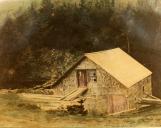 Credits:
Credits:North Shore Archives CSHC
2
Alex Swan Gristmill SiteThis grist mill was operated for 85 years by the Swan family thought to be related to Alex Swan. He built the original gristmill on a branch of the French River known as 'Mill Brook' in 1840. In 1852 John Swan, son of 'Miller' Jimmie was running the mill. Around 1900 the water wheel was changed to an overshot wheel and a more modern turbine. Wilfred Swan was the last operator.
3
Evidence Today: Alex Swan Family Mill Site, New Annan, Nova Scotia, Canada13 August 2010
New Annan, Nova Scotia, Canada
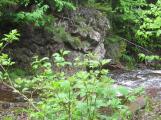 Credits:
Credits:Jim MacIntosh
4
In order to build a dam, firm bedrock exposures in the banks were necessary. In this case the bedrock was only on one side of the brook.5
Hand-fitted Stones, Alex Swan Family Mill Site, New Annan, Nova Scotia, Canada13 August 2010
New Annan, Nova Scotia, Canada
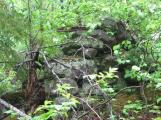 Credits:
Credits:Jim MacIntosh
6
Where necessary a 'dry' stone wall was constructed, with boulders carefully placed so they did not wash away in the spring flood waters. This was built on the south side of the brook, on the Swan property, where there were no suitable natural outcrops.7
Dam logs, Alex Swan Family Mill Site, New Annan, Nova Scotia, Canada13 August 2010
New Annan, Nova Scotia, Canada
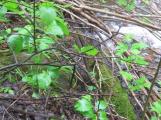 Credits:
Credits:Jim MacIntosh
8
Timber was readily available for the construction of a dam; these had to withstand a considerable force of water in the spring when the large snowfalls of winter, melted. Careful searching only revealed one or two logs from the original dam, where they had become trapped in the bank.9
Downstream, Alex Swan Family Mill Site, New Annan, Nova Scotia, Canada13 August 2010
New Annan, Nova Scotia, Canada
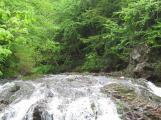 Credits:
Credits:Barbara Baird
10
In July the water in the brook was still fast flowing, but by August the volume will have decreased; a dam would have helped regulate the flow. Once a dam was constructed, the build-up of water supplied various mills; this could be a problem as some mills lower down the water-course might find themselves short of water if too much had been diverted by another mill owner.11
The Flume, Alex Swan Family Mill Site, New Annan, Nova Scotia, Canada13 August 2010
New Annan, Nova Scotia, Canada
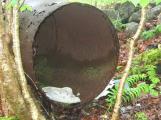 Credits:
Credits:J. MacIntosh
12
Remains of the former equipment used in the mill area are still apparent. Rusting and scattered as they were probably caught up in spring floods, they litter the valley floor. Part of the former flume, carrying water from the dam to the mill is about 30 inches (75 cm) across.13
Turbine With Fins Inside, Alex Swan Family Mill Site, New Annan, Nova Scotia, Canada13 August 2010
New Annan, Nova Scotia, Canada
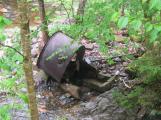 Credits:
Credits:J. MacIntosh